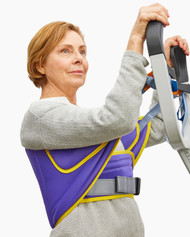Manual handling is a crucial aspect in various workplaces, especially in healthcare settings, but it can pose significant risks if not managed properly. Identifying and addressing the main risk factors can help reduce the incidence of injuries. Manual handling refers to any work that requires force to lift, lower, push, pull, carry, move, hold or restrain. Here are the four main risk factors for manual handling, supported by references:
1. Task-Related Factors
Tasks that require awkward postures, repetitive movements or heavy lifting are significant contributors to manual handling injuries.
- Heavy Lifting: Tasks involving the lifting of heavy objects or patients increase the risk of musculoskeletal disorders.
- Repetitive Movements: Repeating the same movements can cause cumulative trauma to muscles and joints.
- Awkward Postures: Bending, twisting and reaching increase the risk of strain and injury.
- Prolonged Duration: Extended periods of manual handling tasks can lead to fatigue, thereby increasing injury risk.
2. Load-Related Factors
The characteristics of the load, such as its weight, size, shape and stability, play a crucial role in manual handling safety.
- Weight: Heavier loads are more likely to cause injury.
- Size and Shape: Bulky or awkwardly shaped loads are harder to handle safely.
- Stability: Unstable or unbalanced loads can shift unexpectedly, increasing the risk of injury.
- Grasping Difficulty: Loads that are difficult to grasp securely can slip, leading to sudden movements and potential injuries.
3. Environment-Related Factors
The physical environment in which manual handling tasks are performed can significantly influence the risk of injury.
- Space Constraints: Limited or cluttered space can prevent the use of proper lifting techniques.
- Storage: Avoid storing heavier items above shoulder height as this can increase strain on the shoulders and spine.
- Floor Conditions: Slippery, uneven or cluttered floors can lead to slips, trips and falls.
- Lighting: Poor lighting can obscure hazards and impede safe handling practises.
- Temperature and Humidity: Extreme temperatures or high humidity can reduce physical performance and increase fatigue.
4. Individual-Related Factors
Individual characteristics, including physical fitness, training and health conditions, can affect susceptibility to manual handling injuries.
- Physical Fitness: Poor physical fitness or strength can increase injury risk.
- Training and Experience: Lack of proper training in manual handling techniques raises the risk of improper lifting and injuries.
- Health Conditions: Pre-existing conditions such as back pain or arthritis can be exacerbated by manual handling tasks.
- Fatigue and Stress: Physical and mental fatigue or stress can impair a worker’s ability to handle tasks safely.
Conclusion
By understanding and addressing these four main risk factors - task-related, load-related, environment-related and individual-related - employers can develop effective strategies to minimise manual handling injuries. Implementing ergonomic solutions, providing regular training, and conducting thorough risk assessments are essential steps in creating safer workplaces. Some key principles to reduce hazardous manual handling include:
- Maintaining a neutral spine when performing tasks
- Using the large muscles in the legs rather than shoulders and arms
- Using your body weight to move objects
- Holding loads close to your body
- Not twisting your body when performing tasks, move your feet instead
- Keeping elbows close to your body when moving objects or performing tasks
- Bracing on your body or performing tasks on a stable surface
- Using aids such as hoists and slide sheets whenever possible.
References:
- Hignett, S., & Crumpton, E. (2007). Work-related musculoskeletal disorders in health and social care. Occupational Medicine, 57(1), 1-2.
- Waters, T. R., Putz-Anderson, V., Garg, A., & Fine, L. J. (1993). Revised NIOSH equation for the design and evaluation of manual lifting tasks. Ergonomics, 36(7), 749-776.40
- Hignett, S. (1996). Work-related back pain in nurses. Journal of Advanced Nursing, 23(6), 1238-1246.
- Waters, T. R. (2007). When is it safe to manually lift a patient? The Revised NIOSH Lifting Equation in Medical Settings. American Journal of Nursing, 107(8), 53-58.
- Marras, W. S., Davis, K. G., Kirking, B. C., & Bertsche, P. K. (1999). A comprehensive analysis of low-back disorder risk and spinal loading during the transferring and repositioning of patients using different techniques. Ergonomics, 42(7), 904-926.
- Westgaard, R. H., & Winkel, J. (1997). Ergonomic intervention research for improved musculoskeletal health: A critical review. International Journal of Industrial Ergonomics, 20(6), 463-500.
- Garg, A., & Owen, B. (1992). Reducing back stress to nursing personnel: An ergonomic intervention in a nursing home. Ergonomics, 35(11), 1353-1375.
2nd Aug 2024
